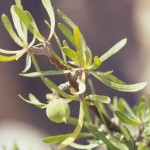Leatherstem, Sangre de Drago
Jatropha dioica Cerv.
Euphorbiaceae (Spurge family)
Description
Leatherstem is an erect, perennial, shrubby plant with simple, linear leaves. It is a member of the spurge family (Euphorbiaceae). The stems are quite rubbery and flexible, thus the name Leatherstem. It can form colonies up to 6 ft or 1.8 m across with underground runners (i.e., rhizomes). The plant’s sap is clear to yellowish until exposed to air when it turns blood red, thus the name Sangre de Drago. Leatherstem ranges from 1 to 3 ft or 0.3 to 0.9 m tall. Leaves have entire margins, rounded apices, and glabrous surfaces. Though the leaves are typically unlobed, there may be some leaves with 3 shallow lobes. Flowers are small and white to pink, appearing in clusters along the stem. Blooming occurs from April to June. Seeds are gray-brown, spherical, and formed in a leathery capsule. There are two varieties of Leatherstem, var. dioica, and var. graminea. These varieties differ slightly and may hybridize. Jatropha dioica var. dioica tends to have oblanceolate to narrowly obovate leaves, distinct sepals, and pinkish-white petals. Jatropha dioica var. graminea tends to have linear to spatulate leaves and white petals.Habitat
Leatherstem grows on gravelly bluffs, hillsides, and ravine slopes of the South Texas Plains, the Edwards Plateau, and Trans-Pecos areas. It also grows south into Mexico. It has a very high heat tolerance.Toxic Agent
Leatherstem is poisonous to sheep and goats. The major toxic agents are phorbol esters, which severely irritate the stomach lining. A limited number of feeding experiments by the Texas Agricultural Experiment Station found that Leatherstem was toxic but not fatal to a sheep fed 2 percent of its body weight of green leaves. Seeds were fatal to a lamb at 3 percent of its body weight in the three doses over 12 days. A goat fed 3.7 percent of its body weight of Leatherstem leaves developed progressive anemia and died.Signs of Livestock Ingestion
Signs of Leatherstem include:- Severe gastric inflammation
- Abdominal pain
- Vomiting
- Diarrhea
Management Strategies
Leatherstem is relatively unpalatable to livestock. Grazing management practices that improve or maintain good quality range condition and avoid overgrazing reduce the incidence of poisoning from Leatherstem. Proper mineral supplementation programs, especially providing phosphorous, can also reduce livestock losses to the plant.Images
Plant Characteristics
Flower Color: Pink, White
Seed Type: Fruit/Berry
Duration: Perennial
Stem Texture: Hairless/Smooth
Growth Habit: Shrub (Woody)
Leaf Shape
 : Simple with Pinnate or Parallel Venation
: Simple with Pinnate or Parallel Venation
Season: Warm
Distribution
 : 02 - Gulf Prairies and Marshes, 06 - South Texas Plains, 07 - Edwards Plateau, 10 - Trans-Pecos
: 02 - Gulf Prairies and Marshes, 06 - South Texas Plains, 07 - Edwards Plateau, 10 - Trans-Pecos
Distributions
Distribution refers to the ecological region in Texas that a plant has been found. You can also view a clickable map.
Book: Toxic Plants of Texas (B-6105)
Collection: Toxics
Livestock Affected: Goats, Sheep
Livestock Signs: Abdominal Pain, Colic, Diarrhea, Vomiting/Regurgitation




